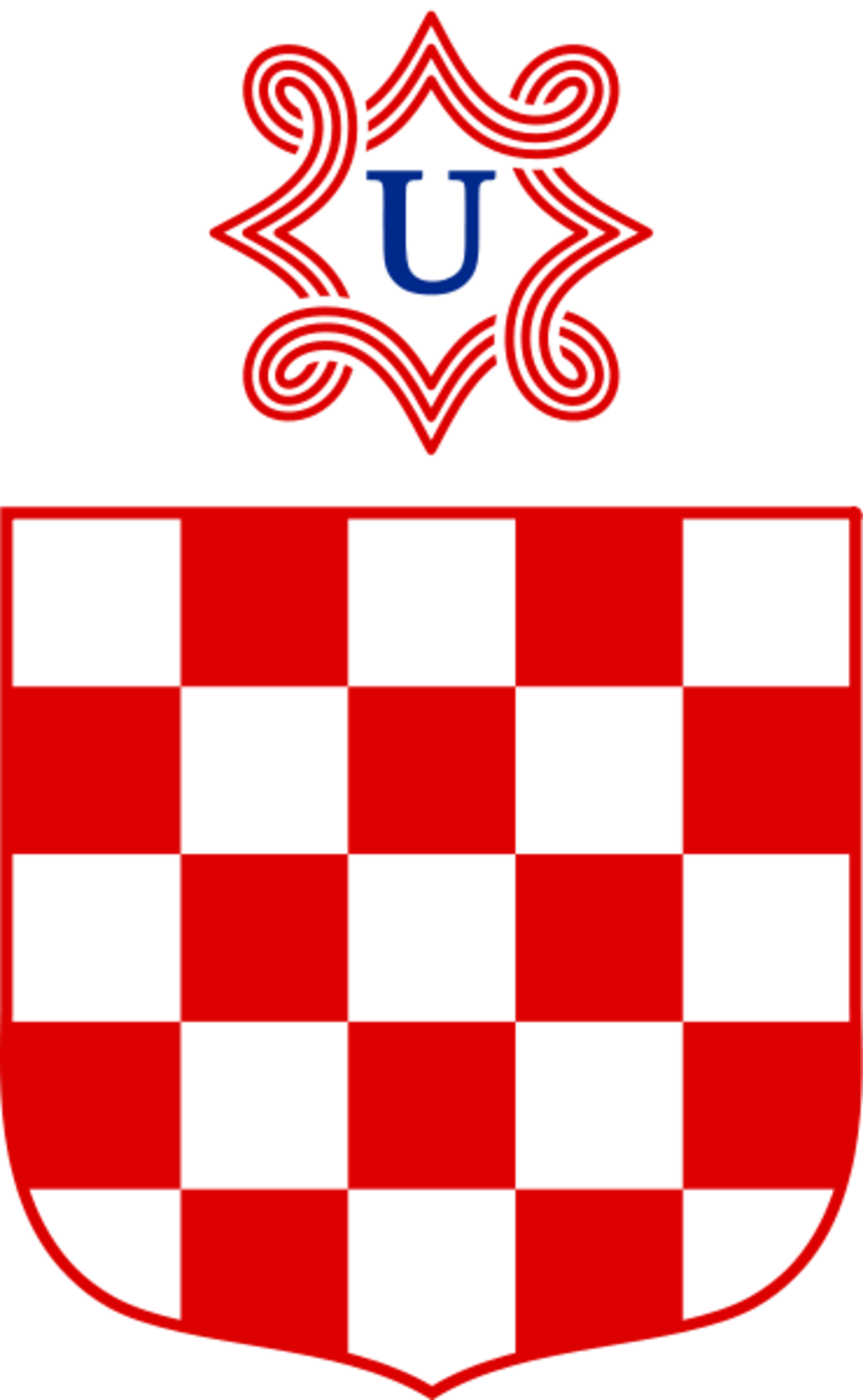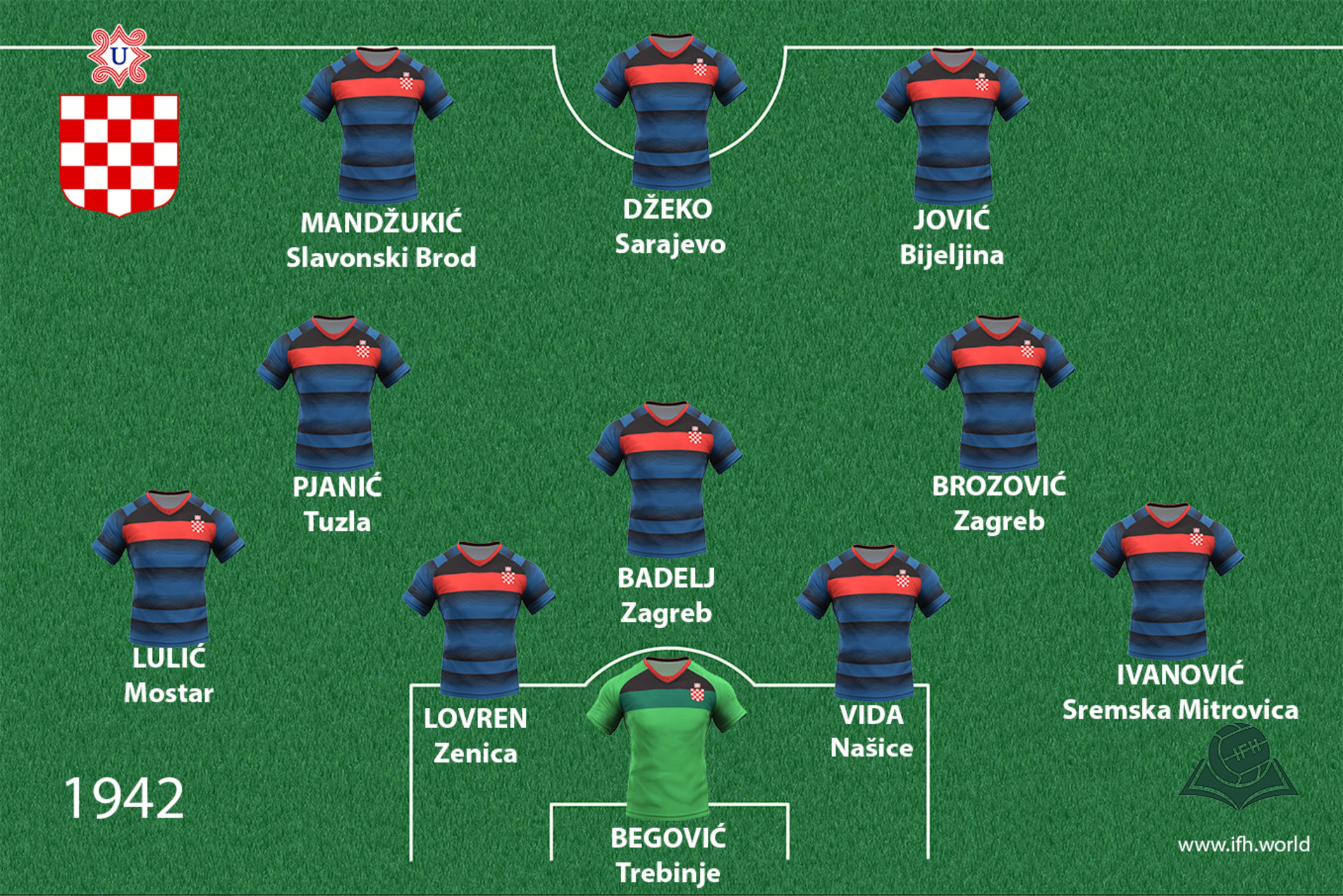Independent State of Croatia
Ever since the creation of nations and national countries began in Europe and the world in the 19th century, Independent State of Croatia, at least in theory, represented the first independent Croatian national state. It was created under Ustaša leadership, whose movement, on the other hand, was an expression of old tribal ideology and system of values of patriarchal Croatian population of the Dinaric area.

Coat of arms
Shirt
| Position | First name | Last name | Mjesto rođenja | Like | Dislike | |
|---|---|---|---|---|---|---|
| GK | Asmir | BEGOVIĆ | Trebinje |
21 |
11 |
|
| GK | Josip | POSAVEC | Varaždin |
20 |
6 |
|
| DC | Dejan | LOVREN | Zenica |
46 |
4 |
|
| DC | Emir | BIČAKČIĆ | Zvornik |
2 |
4 |
|
| DC | Neven | SUBOTIĆ | Banja Luka |
6 |
3 |
|
| DC | Vedran | ĆORLUKA | Derventa |
40 |
5 |
|
| DRC | Branislav | IVANOVIĆ | Sremska Mitrovica |
43 |
15 |
|
| DRC | Tin | JEDVAJ | Zagreb |
29 |
7 |
|
| DLC/DMC | Ervin | ZUKANOVIĆ | Sarajevo |
2 |
3 |
|
| DRLC | Domagoj | VIDA | Našice |
34 |
6 |
|
| DL | Josip | PIVARIĆ | Zagreb |
7 |
5 |
|
| DMC | Milan | BADELJ | Zagreb |
45 |
6 |
|
| MC | Miralem | PJANIĆ | Tuzla |
41 |
3 |
|
| ML/DL | Senad | LULIĆ | Mostar |
8 |
6 |
|
| MRLC | Marcelo | BROZOVIĆ | Zagreb |
45 |
5 |
|
| AMC/SS | Josip | ILIČIĆ | Prijedor |
10 |
0 |
|
| AMRLC | Marko | ROG | Varaždin |
18 |
2 |
|
| AMRLC | Marko | MARIN | Bosanska Gradiška |
1 |
2 |
|
| MRL | Edin | VIŠĆA | Olovo |
2 |
3 |
|
| FRLC | Luka | JOVIĆ | Bijeljina |
25 |
4 |
|
| FRLC | Mario | MANDŽUKIĆ | Slavonski Brod |
50 |
1 |
|
| FC | Edin | DŽEKO | Sarajevo |
35 |
5 |
|
| FC | Riad | BAJIĆ | Sarajevo |
2 |
1 |
|
| FC/SS | Andrej | KRAMARIĆ | Zagreb |
44 |
3 |
Most Croats happily accepted the wartime defeat of Yugoslavia and the establishment of the new country[1] and the reasons of this enthusiasm can be found in political atmosphere of the Kingdom of Yugoslavia (unresolved “Croatian Question”, the assassination of Stjepan Radić, the 6 January Dictatorship, the question of concordat with the Vatican, the image of “Serbs” as someone who enjoys privileges, etc.).[2]
Independent State of Croatia can not be solely identified with the Ustaša regime, which was placed to the head of the country by the Italians and Germans, but also with a large number of Croatian peasants, laborers, professors, clerks, and citizens who fought for its preservation.[3] Still, many actions of the Ustaša politics (ceding of Split and its environs, creation of the Italian and German zones of influence, presence of their armies, racial laws, etc.) would soon lead to disappointment among the wider masses and joining the Partisans and the Chetniks, which would result in a bloody civil war.[4]
Territorially, the country covered the area between the Drina and Danube rivers in the east, while it had to cede parts of Dalmatia, including Split, in the West (Zadar, Rijeka and Istria were already under Italy ever since the dissolution of Austria-Hungary). The main goal of Ustaša ideology, one they had since before the war, was the creation of an “ethnically clean Croatian territory”,[5] which would as a consequence have mass persecution and killings, targeted foremost against Serbs, Jews and Roma.[6] As far as Muslims were concerned, the Ustaša considered them “the flower of the Croatian nation”, deliberation originally outlined by Croatian politician Ante Starčević back in the 19th century.[7]
The creation of the Independent State of Croatia had the support of the Catholic Church, even though the policy of the Church during the war was much too complex to be classified as collaborationist.[8] Such a stance by the Church was understandable for various reasons. The Independent State of Croatia considerably institutionalized Catholicism both as a state church and cohesive force of its country.[9] Aside from being returned to a privileged position in the country, as opposed to the period of the Kingdom of Yugoslavia, and having material wealth ensured, the greatest opponent of the Church was atheist communism.[10]
The Ustaša movement was the expression of the system of values of the patriarchal population of the Dinaric area,[11] and can not be understood without an insight into it. The regime did accept numerous elements of the Nazi and Fascist ideology (cult of the leader,[12]official greeting, single-party dictatorship, an army of the Party, establishment of parallel services and institutions, racial laws, “cleansing of the language”, etc.)[13], but it was only compatible with them, not identical.[14]
The support and foundation of Pavelić’s regime was the peasant part of the Croatian people from the Dinaric area (Zagora, Herzegovina, Lika, Bosnia), where most of the higher political and military officials originated.[15] The country was imagined by the Ustaša as an extended family of the patriarchal type, in which all authority lies in the hands of the elder, in this case Ante Pavelić.[16] The Ustaša movement itself, as, after all the Chetnik movement, was the continuation of old intertribal conflicts on the patriarchal Dinaric area and the fruit of centuries-old transgenerational transfer of hate.[17] Geographical circumstances and socio-political processes (centuries of adapting to difficult conditions of life, frequent wars, guerilla warfare, mixed multiethnic and multireligious society, etc.) affected the way of life and psyche of the “Dinarans” (regardless of their national orientation), i.e. the forming of a mentality whose negative characteristics (paranoia, narcissism and projecting) represent fertile soil for the emergence and development of ethno-nationalistic views.[18] Psychological traits of ethno-nationalists are characterized by a tendency to endlessly simplify complex societal reality, with inevitable alignment of everything on two sides (“ours and theirs”, “good and bad”).[19] The Dinaran lives in constant anxiety and fear of “the Others” – neighbors,[20] with dominant themes being “sacrifice”, “sacrificing”, “historical truth”, “evil of others”, “our dead”, etc.[21] The inevitability of demarcation is also noticeable, i.e. one must know and see exactly where “ours” extends to, and where “theirs” begins – necessitating the division of land, forests, rivers, towns, neighborhoods, property, the past, people prof the past, cultural goods, etc.[22]
- [1] Ivo GOLDSTEIN, Hrvatska 1918-2008, Zagreb, 2008, 224
- [2] Srećko Matko DŽAJA, Politička realnost jugoslavenstva : (1918. - 1991.) , Sarajevo, 2004, 81
- [3] Ivo RENDIĆ MIOČEVIĆ, Uvod u hrvatsku interdisciplinarnu povijest, Slavonski Brod, 2011, 407
- [4] Mario JAREB, Hrvatski nacionalni simboli, Zagreb, 2010, 286; Darko DUKOVSKI, Povijest Srednje i Jugoistočne Europe 19. i 20. stoljeća , sv.II., Zagreb, 2005, 182; Sabrina P.RAMET '' Nezavisna Država Hrvatska – Uvod,'' Nezavisna Država Hrvatska 1941.-1945. (ur. Sabrina P. Ramet), Zagreb, 2009, 16
- [5] Sabrina Petra RAMET, Tri Jugoslavije : izgradnja države i izazov legitimacije : 1918.- 2005., Zagreb, 2009, 161-162
- [6] Tihomir CIPEK, ''Stoljeće diktatura u Hrvatskoj'', Hrvatska politika u XX. Stoljeću, (ur. Ljubomir Antić), Zagreb, 2004, 295
- [7] ''Marjan DIKLIĆ, ''Dr.Ante Starčević: u povodu 110.obljetnice smrti (1823-1896)'', Pravaška misao i politika (ur. Jasna Turkalj, Zlatko Matijević, Stjepan Matković), Zagreb, 200., 22
- [8] Eric J. HOBSBAWM, Doba ekstrema : kratko dvadeseto stoljeće 1914.-1991, Zagreb, 2009, 148
- [9] Vjekoslav PERICA, ''Uloga crkava u konstrukciji državotovrnih mitova Hrvatske i Srbije'',Historijski mitovi na Balkanu (ur. Husnija Kamberović ), 2003 Sarajevo, 215
- [10] Mark BIONDICH, ''Kontroverze u vezi s Katoličkom crkvom u Hrvatskoj u vrijeme rata 1941.-1945.'', Nezavisna Država Hrvatska 1941.-1945. (ur. Sabrina P. Ramet), Zagreb, 2009, 145; Vjekoslav Perica, Balkanski idoli, svezak 2, Beograd: XX.vek, 2006., 140
- [11] Ivo RENDIĆ MIOČEVIĆ, Hrvatski identitet : trajnost i fluidnost - usporedba Kvarnera i gorske Dalmacije, Rijeka, 2006, 149
- [12] Ivo GOLDSTEIN, Hrvatska 1918-2008, Zagreb, 2008, 147
- [13] Mario JAREB, Hrvatski nacionalni simboli, Zagreb, 2010., 269; Ivo GOLDSTEIN, Hrvatska 1918-2008, Zagreb, 2008, 147
- [14] Ivo RENDIĆ MIOČEVIĆ, Zlo velike jetre, Split, 1996, 326; Ivo RENDIĆ MIOČEVIĆ, Uvod u hrvatsku interdisciplinarnu povijest, Slavonski Brod, 2011, 411; Ivo ŽANIĆ, ''Prevarena povijest : guslarska estrada, kult hajduka i rat u Hrvatskoj i Bosni i Hercegovini, 1990. - 1995. Godine'', Zagreb, 1998, 330
- [15] Ivo RENDIĆ MIOČEVIĆ, Zlo velike jetre, Split, 1996, 341
- [16] Ivo RENDIĆ MIOČEVIĆ, Uvod u hrvatsku interdisciplinarnu povijest, Slavonski Brod, 2011, 21
- [17] Ivo RENDIĆ MIOČEVIĆ, Uvod u hrvatsku interdisciplinarnu povijest, Slavonski Brod, 2011
- [18] Ivo RENDIĆ MIOČEVIĆ, ''Etnopsihologijski okvir hrvatske i srpske nacije'', Migracijske teme 16/2000, 145; Ivo RENDIĆ MIOČEVIĆ, Hrvatski identitet : trajnost i fluidnost - usporedba Kvarnera i gorske Dalmacije, Rijeka, 2006, 155; Ivo RENDIĆ MIOČEVIĆ, Uvod u hrvatsku interdisciplinarnu povijest, Slavonski Brod, 2011 116; Ivo RENDIĆ-MIOČEVIĆ, ''Kako simptomi postaju dijagnoza'', http://www.matica.hr/vijenac/514/Kako%20simptomi%20postaju%20dijagnoza/; Ivo RENDIĆ – MIOČEVIĆ, ''Etnopsihologija i nacije u Iliriku'', Dijalog povjesničara – istoričara, 1 (ur. Hans-Georg Fleck i Igor Graovac ) Zagreb, 2000, 96
- [19] Dušan KECMANOVIĆ, Etnonacionalizam II, Beograd, 2014, 296
- [20] Ivo RENDIĆ MIOČEVIĆ, Zlo velike jetre, Split, 1996, 127
- [21] Dušan KECMANOVIĆ, Etnonacionalizam II, Beograd, 2014, 141, 142
- [22] Dušan KECMANOVIĆ, Etnonacionalizam II, Beograd, 2014., 128
Sources
- Mark BIONDICH, ''Kontroverze u vezi s Katoličkom crkvom u Hrvatskoj u vrijeme rata 1941.-1945.'', Nezavisna Država Hrvatska 1941.-1945. (ur. Sabrina P. Ramet), Zagreb, 2009.
- Tihomir CIPEK, ''Stoljeće diktatura u Hrvatskoj'', Hrvatska politika u XX. Stoljeću, (ur. Ljubomir Antić), Zagreb, 2004.
- ''Marjan DIKLIĆ, ''Dr.Ante Starčević: u povodu 110.obljetnice smrti (1823-1896)'', Pravaška misao i politika (ur. Jasna Turkalj, Zlatko Matijević, Stjepan Matković), Zagreb
- Darko DUKOVSKI, Povijest Srednje i Jugoistočne Europe 19. i 20. stoljeća , sv.II., Zagreb, 2005.
- Srećko Matko DŽAJA, Politička realnost jugoslavenstva : (1918. - 1991.) , Sarajevo, 2004.
- Ivo GOLDSTEIN, Hrvatska 1918-2008, Zagreb, 2008.
- Eric J. HOBSBAWM, Doba ekstrema : kratko dvadeseto stoljeće 1914.-1991, Zagreb, 2009.
- Mario JAREB, Hrvatski nacionalni simboli, Zagreb, 2010.
- Dušan KECMANOVIĆ, Etnonacionalizam II, Beograd, 2014.
- Vjekoslav Perica, Balkanski idoli, svezak 2, Beograd: XX.vek, 2006.
- Vjekoslav PERICA, ''Uloga crkava u konstrukciji državotovrnih mitova Hrvatske i Srbije'',Historijski mitovi na Balkanu (ur. Husnija Kamberović ), 2003, Sarajevo
- Sabrina P.RAMET '' Nezavisna Država Hrvatska – Uvod,'' Nezavisna Država Hrvatska 1941.-1945. (ur. Sabrina P. Ramet), Zagreb, 2009.
- Ivo RENDIĆ – MIOČEVIĆ, ''Etnopsihologija i nacije u Iliriku'', Dijalog povjesničara – istoričara, 1 (ur. Hans-Georg Fleck i Igor Graovac ) Zagreb, 2000.
- Ivo RENDIĆ MIOČEVIĆ, Hrvatski identitet : trajnost i fluidnost - usporedba Kvarnera i gorske Dalmacije, Rijeka, 2006.
- Ivo RENDIĆ MIOČEVIĆ, ''Etnopsihologijski okvir hrvatske i srpske nacije'', Migracijske teme 16/2000.
- Ivo RENDIĆ-MIOČEVIĆ, ''Kako simptomi postaju dijagnoza'', http://www.matica.hr/vijenac/514/Kako%20simptomi%20postaju%20dijagnoza/;
- Ivo RENDIĆ MIOČEVIĆ, Uvod u hrvatsku interdisciplinarnu povijest, Slavonski Brod, 2011.
- Ivo RENDIĆ MIOČEVIĆ, Zlo velike jetre, Split, 1996.
- Ivo ŽANIĆ, ''Prevarena povijest : guslarska estrada, kult hajduka i rat u Hrvatskoj i Bosni i Hercegovini, 1990. - 1995. Godine'', Zagreb, 1998.
